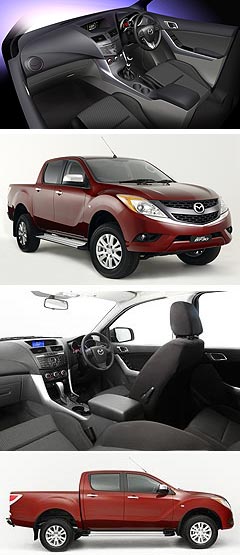Sydney show: Mazda’s new ute a ‘sophisticated beast’
BY MARTON PETTENDY | 15th Oct 2010

“The power and the beauty of the Australian environment has strongly affected the design of the all-new BT-50,” said Ryo Yanagisawa, who spent two years in Melbourne designing the interior and exterior of the vehicle.
“While developing the all-new BT-50, I was able to spend my time off travelling, and I was extremely inspired by the sweeping dynamic landscapes which can never be found in Japan.” Bigger in all key dimensions both inside and out, the redesigned BT-50 is cloaked in an unmistakably Mazda bodyshell that makes both the current model and many of its newer rivals look small – and positively dated.

“We wanted to break out from the zone of our competitors and create an all-new type of vehicle that was athletic and assured,” he said.
“This has created a truly new world of pick-up truck and we have named it ‘active lifestyle vehicle’.
“The vehicle will turn heads in the street with a presence that will grab everyone’s attention. We wanted something with pure dominance – that was the design team’s goal.
‘When planning the design concept, one picture that caught my attention was a photo of a lion. The crouching beast with its presence and dominance, sharp glaring eyes and a profile so intelligent … this is exactly the image I was after.
“I condensed all of these thoughts into the words ‘sophisticated beast’.” Mr Yanagisawa, who also helped create the 1999 and 2005 Mazda5, 1997 626 wagon and the CX-9, said the ground-breaking new BT-50 design marked a revolutionary step from the styling of its more conservative predecessor.
“To make the design a reality, we needed a huge design breakthrough,” he said.
“(The current BT) was a very modern design at the time of its release and expressed well the idea of function that is expected of a pick-up truck. However, we must say that the relationship between this and the Mazda brand message of Zoom-Zoom was somewhat weak, so in the all-new BT we have taken a radical approach to the architecture by adding a wedge shape. This is shaped like a lion about to pounce on its prey.” Mr Yanagisawa said the next BT-50 was not designed under Mazda’s next-generation design philosophy of ‘Kodo, soul of motion’, which was previewed last month by the Shinari concept car, but borrowed styling cues from the striking four-door ‘coupe’.
“I hope you feel the dynamic resonance between the two vehicles,” he said. “(But) to be honest the all-new BT was not actually designed according to the principals of Kodo … but there are some fundamental commonalities between the two designs.
“The most striking characteristic is the feature line that runs from the front fender to the rear-end. This is actually an evolution of the prominent fender that has been part of Mazda designs since RX-8. We called it ‘dynamic prominent fender’.” He said this architectural innovation also extends to the passenger car-like interior, which “inhabits a similar world” as the Shinari.
“The current BT-50 cabin has an attractive, modern environment which is very truck-like. However, for the all-new BT50 we tried to create a totally more sophisticated, high-grade sporty environment.
“They both have a wrap-around cockpit and an asymmetrical design that optimises passenger comfort. The instrument panel flows organically into the centre console, which is totally different to any conventional pick-up truck. We have transformed the architecture at a fundamental level.” Mr Yanagisawa said a highlight of the BT-50 design was its horizontal tail-light design, which extends onto the tailgate, stamping it firmly as a member of the Mazda family and differentiating it from other utes.
“The current BT-50 has a vertical tail-light,” he said. “This is much the same for other pick-up trucks, so if you look at them from a distance they all look very similar.
“A horizontal tail-light is much more suggestive of speed, which is why we adopted it for all-new BT-50. This was a very big challenge for a pick-up truck. However, by doing so we were able to differentiate ourselves from all the other brands and achieve a vehicle you can identify as a Mazda just from one glance.
“The all-new BT-50 has achieved a Mazda-unique design which can be easily identified from 100 metres away and from any direction. It has dominating presence and is extremely bold and beautiful, which is unprecedented by any other pick-up truck.
“The all-new BT-50 has broken free from all the modern concepts of the pick-up truck and we see the birth of a completely new type of vehicle – the sophisticated beast, the active lifestyle vehicle.”